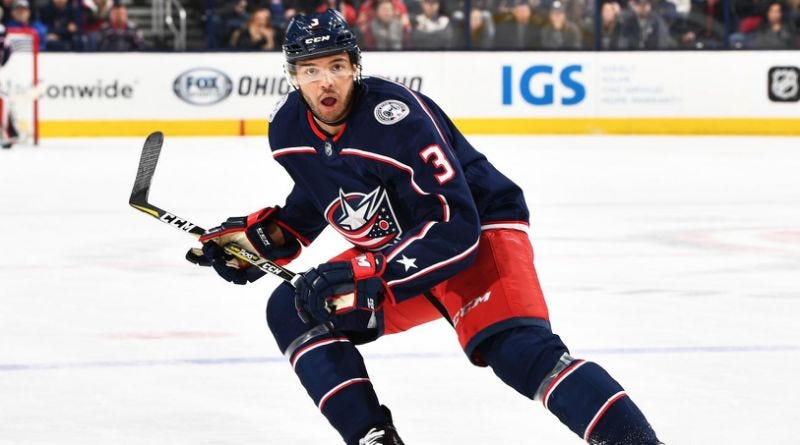Fresh Cuts: MacKinnon, Drouin, and Jones
A new series which will look at various topics in hockey using analytics.

With hockey coming back, there’s not going to be much time or reason for me to write those big deep dive articles I’ve done in the past - most people are going to be too wrapped up in the playoffs to want to read an in-depth analysis of Valeri Nichushkin. With that in mind I’ve decided to start a regular series here which I’m tentatively calling “Fresh Cuts.” (I am extremely open to a different title) This will feature 3-5 shorter pieces on whatever topics interest me that week. This first edition will look at three 2013 top-4 picks, checking out Nathan MacKinnon’s supposed carrying of the Avalanche, Jonathan Drouin’s possible return to his early season form, and Seth Jones’ micro-level impact on the Columbus Blue Jackets.
1. Did MacKinnon Really Carry the Avalanche?

After months and months of hearing about Leon Draisaitl’s generational penalty killing ability and how I should exempt the month of December from consideration etc. etc. I thought I was done with having to hear Hart trophy-related nonsense. Not the case. As I’ve said many times, Artemi Panarin is my MVP if we’re not including Connor Hellebuyck for a number of reasons. But since they announced the nominees I’ve increasingly heard a new narrative saying that Nathan MacKinnon was the most valuable to his team because he led the Avalanche in scoring by 43 points, which clearly means he carried the team to their high position in the standings.
Usually when a player leads their team in scoring by such an insane margin there’s an explanation for it. For Taylor Hall in 2017-18, it was because his most frequent 5v5 linemates did not play on the #1 powerplay unit with him. He led his linemate Nico Hischier in EV points by 7, but Hischier had only 8 PP points to Hall’s 37, which contributed to a total margin of victory of 41 points. In MacKinnon’s case, it’s because of injuries: #29 played 32% of his EV minutes with Landeskog and Rantanen, down from 58% in 2018-19 because both guys missed significant time.
So the fact that MacKinnon was able to maintain elite production despite injuries is exactly why he carried the team, right? Except that the Avs depth was actually excellent this season despite not racking up gaudy point totals. When MacKinnon was on the ice the Avalanche scored 60.5% of the goals, but when he was on the bench his team still scored 57.1% of them. Put another way, without MacKinnon, the Avalanche had a higher goals for percentage than 28 teams (and every other team in the Western Conference). Meanwhile some other MVP candidates like Artemi Panarin or Elias Pettersson had to watch teams that were barely better than the Red Wings when they were on the bench.
None of this is to say that MacKinnon isn’t a hugely impactful player or doesn’t deserve Hart consideration - just that team point differential can be a bit misleading when it comes to measuring how much a team really got “carried.”

2. What’s With the Jonathan Drouin Hype?

Lately I’ve been listening to a lot of French-language hockey podcasts to help reclaim my pretty well fully-decayed bilingualism. That means I’ve been hearing a lot about the Canadiens. There have been some weird tidbits here and there (including a fascination with playing Noah Juulsen or Cale Fleury instead of the perfectly serviceable Christian Folin) but the obsession with Jonathan Drouin has kind of surprised me.
I’m a big fan of Drouin’s game - in the QMJHL at least. Watching him live in Halifax, I’d never seen someone so gifted with the puck on his stick. But he has stunk with the Canadiens; well below replacement-level in two of his three seasons including his abbreviated 2019-20 campaign. He’s a poor driver of on-ice goals for and expected goals for, he’s miserable defensively, and in the situation where he’s supposed to thrive the most, on the powerplay, he was awful this season in a small sample and barely above replacement level before that.

I’ve heard a lot of analysts talk about how much the Habs will benefit if Drouin can “find his early season form,” when he scored 15 points in 19 games. That’s almost definitely not going to happen, because that “form” was actually luck. A combination of goals going in at a well-above-expected rate and Carey Price stopping the high quality chances he allowed while on the ice gave him the highest PDO above expected (Shooting% Above Expected + Save% Above Expected) of the Canadiens’ forwards by the end of November. In terms of xGF%, Drouin at his “best” ranked 10th out of 13 Habs forwards. When he came back, the luck dried up and he wasn’t on the ice for a single Montréal goal in eight games.
How about if he can find his 2015-16 Tampa Bay form - the season he was supposed to teach Crosby how to play in the clutch? Honestly, it’s probably best for the Habs if he doesn’t. His xGF% was a putrid 38.9% that post-season and a huge chunk of that production came from the powerplay. So unless the Habs can convince Nikita Kucherov to join their special teams unit I wouldn’t bet on a repeat performance.
I haven’t watched enough of Drouin (well, outside of the Halifax Metro Centre anyway) to diagnose what’s “wrong” with his game, but the fact of the matter is that despite his flashy skillset he just doesn’t drive offence in a significant way and he’s a liability defensively. The only thing he can offer the Habs is zero-calorie scoring, which I guess is not something they have in abundance, but in my book that $5.5M contract is burnt money at this point.
3. The Seth Jones Debate Will Never End

Recently Andrew Berkshire gave me a shout-out in an article he wrote for Sportsnet (which as an analyst was appreciated and as a long time reader of his work was very cool). I thought it contained a lot of very interesting insights, and dug deeper into some of the microstat analysis that I was only able to dip my toes into because I only have access to certain tracked stats. A good chunk of what he found reflected what the macrostats say - the Jackets were a little worse defensively with Jones out of the lineup, giving up 2.15 xGA/60 rather than 2.05.
I didn’t get the impression from the piece that Jones’ departure had a significant impact on the Jackets’ transition game, especially since it was only the most granular microstats where the needle moved. A ~9% change in recovered dump-ins leading to a scoring chance is difficult to visualize without a sense of how many fewer actual chances that is over the course of a game. How many fewer is that per game? Or total? Per NaturalStatTrick, the Jackets had ~25 scoring chances per 60 before Jones got hurt and ~24 after, which would mean they lost about 1 per game. Was that the loss of a dump-in chance, or did Jackets mostly compensate for the loss of those chances by generating different types of chances?
Of real note to me is how much Seth Jones’ transition game declined this season. According to Corey Sznajder’s tracking, he was below-average this season in terms of exiting the zone with possession, a major drop-off from the previous two years. As Berkshire notes, he dumps the puck out of his zone a lot nowadays, to such an extent that the Jackets exited with control more often after he got hurt. With that in mind, it might be time to tentatively tamp down the “Seth Jones is elite in transition” motto.
There’s another thing I’m curious about. The narrative behind Jones’ diminished offensive playdriving numbers this season (which were poor to mediocre the last two years anyway) is that he “[changed] his game a little bit, sacrificing offence in order to cover for Zach Werenski and allow him to rove a bit more, while shouldering the defensive load.” But Werenski’s numbers - even his defensive numbers - were actually just as good if not better without Jones this season. Playing with Marcus Nutivaara after Jones’ injury, Werenski’s expected goals against per 60 actually improved (as did his xGF%). According to the SportLogiq data Berkshire cites, after Feb 10th the Jackets allowed 11% more slot passes when Werenski was on the ice than when he was with Jones. Based on public passing data and his minutes, even if we assume the Jones/Werenski pair was average at preventing those chances that translated to probably around ~0.7 more slot passes per game and ~0.25 shots off slot passes per game - maybe 10 extra passes and 2 or 3 extra shot attempts from those passes total in the 14 games Jones was out. Not nothing, but not team-imploding either, especially considering that he apparently compensated for it by preventing other types of chances. The only major difference is that Elvis Merzlikins remembered that he isn’t the best goalie in the world and finally regressed. If Nutivaara can be exchanged for Jones with similar or even better results, what grounds is there to say that Seth Jones is that impactful?

I think Berkshire makes a good point that the stuff that Jones did do this season (controlled entries, good dumps, etc.) is a good match for Toronto’s weaknesses. But I still cannot cobble together a remarkable defenceman out of Seth Jones’ stats. I see a guy who’s sacrificed aspects of his game that helped make him even adequate offensively (namely breakout passes) in the name of playing more conservative hockey that hasn’t paid dividends defensively either. I see a guy whose physical gifts draw the eye and who plays an active game that compiles microstats without having a major positive impact on his team’s performance. And I see a guy whose absence gets credited for his team’s collapse despite the fact that all signs point to a long-overdue goaltending regression as the culprit. I still think he’s overrated. Ah well.



